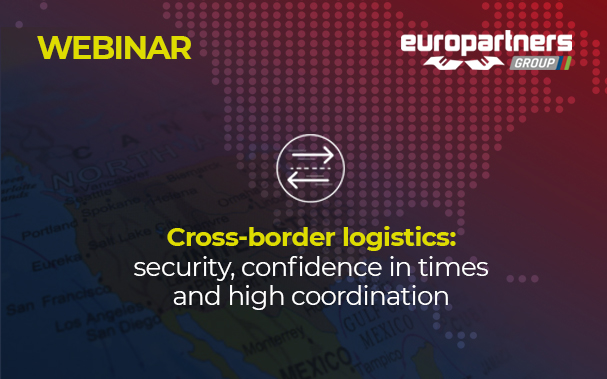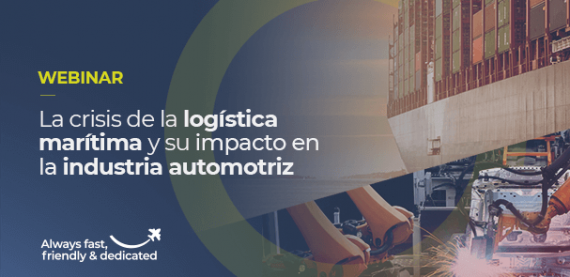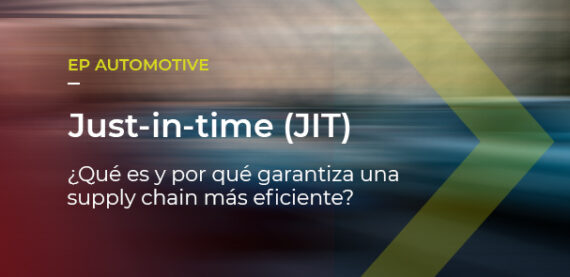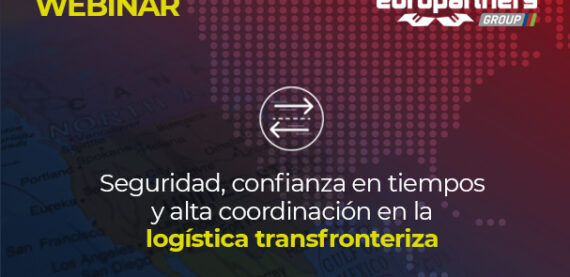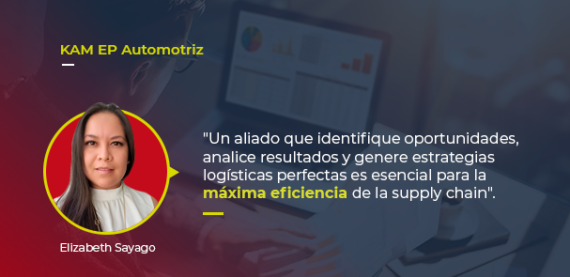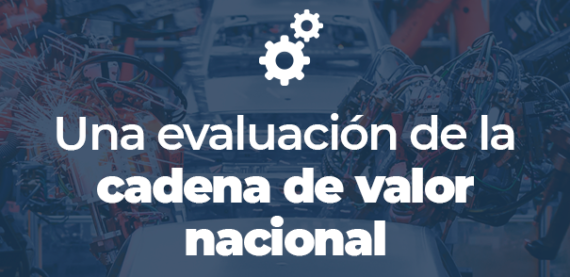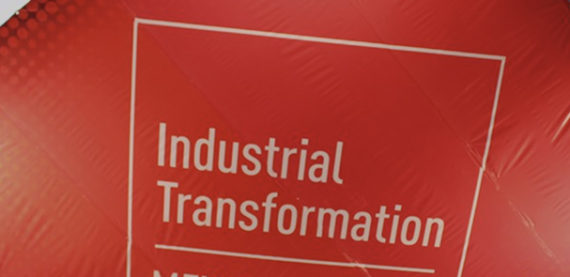Bringing together experienced professionals from Europartners Group and EP America, we presented the main scenarios and the best recommendations for international transportation between the North American borders.
In a poll we’ve published on our social networks, we asked our followers “What is your great logistical challenge on the routes between Canada, the United States and Mexico?”
These were the results:

To offer quality information to our clients and the logistics community in general, we organized a webinar with experts from EP Group in Mexico and EP America, our brand in the United States and Canada.

Cross-border logistics security
Cargo theft statistics show that incidents in Mexico have increased from the beginning of 2020 to the end of the year. Although that growth was probably related to the pandemic, food & beverage products were the main target (38%), while pharmaceutical products only accounted for 5% of the occurrences.
Another significant finding: almost all incidents took place while the cargo was on transit from the shipper to the consignee.

Regarding cargo security while in transit, it is extremely important to follow safety steps to avoid high risks and any kind of incident.
1. Working with certified carriers and vendors
The first important step is to work with carriers and vendors certified by C-TPAT or OEA. Vendors include warehouses, logistic companies and other stakeholders involved in import and export transportation services.
“C-TPAT and OEA vendors follow very strict protocols, so you can rest assured your cargo will be in good hands”, says Esmeralda Garza, Over the Road operation & customer service in EP America.
2. Getting the documentation in order
You need, at least:
- a signed power of attorney (POA),
- the cargo importers and exporters clearly identified,
- certificates of origin
- commercial documents that match the freight transported
3. Define brokers
You need to know beforehand who is the US broker, a Canadian broker and/or a Mexican customs broker who is going to take care of specific parts of the border-crossing documentation, and who represents the importers and the exporters, otherwise your freight might spend a lot of time at the border.
4. Plan the boards of entry and the ports of export
They must be mentioned on some of the documents we’ve listed above, to avoid inspections that may result in delays – and even in a denial of the authorities to accept the documentation, which should be sent back and corrected.
5. Use security seals
In Mexico, they’re called fiscal seals (sellos fiscales). They’re generated with a unique number, that should be added to the paperwork, specially to the customs clearing procedures document (Documento de Operación para Despacho Aduanero – DODA) and pedimentos, which are the documents required at the Mexican borders, and to the cargo compartment.
When the receiver is about to open the doors of the vehicle that transported the freight, they must check that seal is intact, to get the peace of mind that the cargo was moved across countries in perfect conditions.
Sometimes, the seal must be broken due to a customs inspection. That procedure must be documented and communicated to the importers and exporters, with as many details as possible. In this case, we recommend a brand new seal (with a new ID number) must replace the one that was broken.
General recommendations
No matter where you’re shipping to, we always recommend you to:
1. Schedule shipping during daytime
It is safer, both for loading and for unloading procedures.
There are some areas, specially in Mexico, that can be riskier, and the drivers, for their own security, just decide to stay put until the next morning to depart, if the cargo is loaded at the end of the day.
Don’t think as a plan that will delay your delivery. Think that keeping your cargo and the driver secure is more important!
2. Always use units that have a GPS device
It can be installed either on the trailer, the truck, the cabin.
There are also apps that you can install in your own smartphone to track the location of the truck in real time – even to check if it’s going through the safest route, if it’s on schedule, if there’s traffic close by.
3. Communication is key
We always work to have a seamlessly delivery, but things can happen along the way: Traffic accidents, unexpected inspections, roads covered in snow…
It is very important that all the teams are in touch all the time, so you’re not left wandering what’s going on with your shipment.
Partnering up with a professional and customer-driven freight forwarder is very important for your peace of mind.
4. Buy cargo insurance
It is not an extra cost; it is a little investment in serenity.
There are insurances for most incidents that can happen along the way. With the right back-up documentation, you can place a claim and diminish any loses.
5. Start the documentation timely
As soon as your cargo is loaded at the shipper’s site to ensure that the transport unit will reach the border with the right paperwork.
The less the freight stays at the border, the better.
6. Driver must always stop in secure places
If your driver must stop, it must be in a recognized truck stop. The driver must be able to always keep an eye on your freight.
Overall, “most of the steps mentioned above seem obvious, but it is important to master them all. Make sure you confirm all the details with your logistics provider, your shipper and your consignee day to day. If you’re the shipper, take responsibility for all the steps”, advises Alexander Katsouris, director of the Automotive Vertical in Europartners Group, host of the webinar.
Coordination of carriers across different modes of transport
One in every four people that answered our poll stated that coordinating carriers and modes is what worried them the most. For that matter, our experts give you a few good recommendations:
1. Streamlining the flow of goods
You don’t have to feel insecure about opting for a multimodal solution when you have a good logistics partner by your side, such as Europartners Group.
Combining transport modes can actually be timesaving and more efficient.
2. Consider the impact of Incoterms® on transfer pricing
Transfer pricing when embarking through North America involves exchange rates between the three countries’ currencies, which change daily.
With a good freight forwarder by your side, you can process that accurately, real time, using different reliable resources, along with identifying UN Codes and Incoterms® that may benefit you, and help you understand the expectations, delivery & other details.
Working with different countries, it is very important to know about national rules, to comply to every regulation that impact your cargo.
Freight forwarders with local experts and offices can provide you that knowledge and consultancy.
Confidence in transit times
There is a series of decision you, as a logistics professional, have to make to coordinate your international transport plan and trust that the lead time will be fully accomplished.
For this webinar, our senior regional sales manager, Quentin Margain, has prepared a list of criteria to select the best options when building a cross-border logistics plan through North America:
- Urgency to deliver vs. the consequences of a delay
Time critical cargo is more expensive than a freight planned in advanced, but it can be worth every penny if the consequences range from expensive fines, a factory shutdown – or even losing the client.
- Hot cargo (short notice) vs. regular shipments (planned)
As we’ve mentioned on the point above, regular shipments are significantly less expensive than a critical cargo solution – and less stressful, too. Although urgent services with a strategic partner in logistics such as Europartners Group are quite reliable, following a schedule planned in advance give you a lot more peace of mind.
- Day of pick up & delivery
Eliminate the “estimate” from your delivery times and get accurate information about the day your supplier can have the merchandise ready for pick-up and the day the client needs it.
Getting the cargo loaded on a commercial day or on a weekend (or holiday) impact delivery times and the availability of units.
- Type of material
Hazardous materials (HAZMAT) need special licenses to travel and liquid materials cannot be transported using a on-board courier service, for instance.
- Weight and dimension
Getting the accurate information will enable you to design a precise list of transport mode alternatives – and the ones that cannot be considered at all.
The base of a good transport strategy is to understand the pool of options you may have for a freight, to make a good call in every situation.
Main options advantages and risks

- LTL and FTL
Low Truck Load (LTL – consolidations) and Full Truck Load (FTL – hiring a complete truck just for your cargo) services are very cost-efficient for the planned cross-border logistics, with some difficulties with customs clearance and finding operators on the second country.
- Ground expedited
It is more expensive that LTL and FTL because it is faster and you don’t need a transfer, since the vans are not articulated vehicles, but the service is facing issues with lack of units in some borders. On the second quarter in 2021, demand reached +250 loads waiting for a unit in Laredo (TX).
Click here to learn more about the service in a glance
- Small parcel
It is a good domestic option, but the international service can be delayed for the customs procedures.
- Air priority
It is a great service not very well explored in many strategies, but all air freight solutions face difficulties with the saturation of the customs in Mexico City’s international airport. It also has dimension limitations, and you must have a clear knowledge if the cargo can make it to the airline cut-off.
Click here to learn more about the service in a glance.
- Hand carry (on-board courier)
It is one of the fastest solutions for urgent cargo, but a very expensive option on weekends and high seasons of passenger’s flights.
It is a great one also because since the courier takes care of the customs clearance procedures. The courier must know quite well the connections time and specific regulations in some airports.
Click here to learn more about the service in a glance.
- Air charter
It is a fast and dedicated solution for urgent cargo, but it is the one that requires most attention to the documentation, to avoid any discrepancies between the paperwork and the cargo – which may result in terrible airport fees.
Click here to learn more about the service in a glance

In Europartners Group, we work to be more than a cargo agent: we want to be your best strategic partner in logistics, with tailor-made solutions designed for your most specific needs. Contact us now and let’s get your company a seamless cross-border logistics solution.
Click here or below to watch the complete recording of the webinar:
 ESPAÑOL
ESPAÑOL





